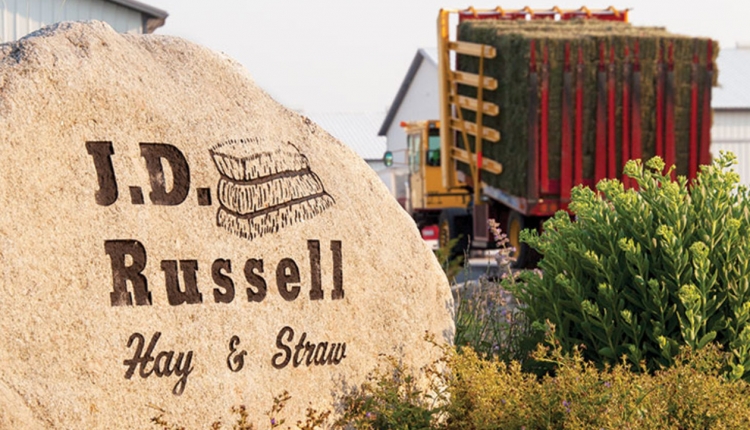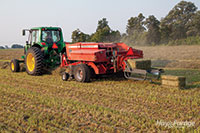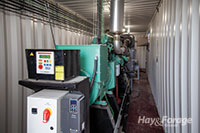These Buckeye haymakers embrace innovation |
| By Mike Rankin, Managing Editor |
|
|
 Every August, the most powerful of tractors assemble in Bowling Green, Ohio, for the National Tractor Pulling Championships. Over 60,000 people fill the Wood County Fairgrounds grandstand during the three-day event. But if an attendee was to travel about 10 miles to the northeast of the grandstand, they’d likely find a different type of tractor pull going on — one that perpetuates throughout the summer. Here, there’s a seemingly nonstop pulling of hay balers — and some extremely unique ones at that. J.D. Russell Hay & Straw is an immaculate poster operation for what a modern small square bale hay farm looks like. That’s right, “modern” and “small square bale” were used in the same sentence. The operation produces nothing but two-tie small square bales of alfalfa-orchardgrass hay and straw on 1,000 acres of owned and rented northwestern Ohio terrain. John Russell and his wife, Denise, began their venture into haymaking modestly. Not from a farming family, Russell’s employer needed someone to make hay for his small herd of cattle. “It was 1983, and I bought a used $300 baler and two $100 hay wagons,” the current president of the National Hay Association recalled. “I worked there for 10 years, and then, in 1991, I bought the five acres that comprises the base of this farm. We moved here in 1992 and built our first hay barn in 1993. We rented some ground to grow hay on, but our biggest thing back then was straw. The remaining 75 acres of the original farm didn’t get purchased until after 2000, and we’ve just kind of kept adding since then.” These days, the Russell farm, which is near Pemberville, Ohio, is still a family-run operation. All of the Russell children — seven in total — grew up baling hay and straw. One of the Russells’ daughters, Julie, and her husband, Stuart Foos, have recently bought into the business and are heavily involved in the day-to-day operations. David, the Russells’ second youngest son, who is attending college, also wants to return to the farm that produces about 200,000 bales of hay and straw each year. During a visit last summer, Russell explained that their hayfields are usually harvested four times per year by late September. Fields are cut with two New Holland self-propelled cutters equipped with Circle C conditioners. Once at the proper moisture, hay is raked onto the dry soil between swaths using H&S V-type wheel rakes. The balers are set to produce uniform 60-pound bales, which are then picked up by three New Holland bale wagons and driven to one of their many hay sheds. It’s all a well-choreographed haymaking dance with performances scheduled whenever Mother Nature allows. Like many farmers, Russell has the inventor gene, but his is comprised of a longer strand of DNA than most are blessed with. He has advanced well beyond a new gate latch design, although he probably has one. Russell is locked-in on harvest efficiency and forage quality. About five years ago, he perfected a self-propelled hay fluffer/tedder that gently lifts and fluffs three swaths at a time and drops them in the same place. The machine has proven beneficial for speed drying ahead of a rain and to rescue wilting hay that unexpectedly gets rained on. Two is better than one A hay fluffer is one thing, but Russell’s ultimate Holy Grail was to improve baling efficiency. “There has been virtually no research and development on small square balers in the past 30 years,” Russell lamented. “When you have a lot of hay to bale in a hurry, it requires running four or five balers and having the associated labor and tractors. We did that for a lot of years, but I knew there had to be a better way.”  John Russell’s double two-tie baler saves labor and time while doing the job of two single-chamber balers. Undeterred, Russell and the custom manufacturer went back to the drawing board. In 2019, they bought two new Hesston 1844 three-tie balers. “We had the idea of essentially cutting them in half, adding 13 inches down the middle, and adding one more knotter and needle,” Russell explained. “This time, instead of feeding two separate chambers, we only fed one with a single plunger and used a knife to cut the bale into two, two-tie bales.” The new double baler also has some other amenities such as a double quarter-turn chute, which aligns the bales in a straight line, and a bale scale that was engineered by one of Russell’s sons. Russell and Foos ran about 70,000 bales through the first baler in 2020, making adjustments along the way. Three more balers have since been built — one for another farm and two more for Russell, but one of his is currently in the possession of a major equipment manufacturer. Russell recently signed an agreement with this manufacturer, which intends to build and market double two-tie balers. “It was never our intent to manufacture these because it’s simply too expensive,” Russell said. “We were out to solve our own problem, and it was worth it to us. We won’t be building any more; in fact, we are no longer allowed to in accordance with our agreement,” he added. What Russell and Foos will be doing is selling off their inventory of standard balers. A new farm addition Field testing the new double two-tie baler wasn’t the only new venture on the Russell farm during the summer of 2020. They also made the decision to install a hay dryer. The Chinook dryer, which was initially designed for large square bales, had to be slightly modified to accommodate small square bales and is the first of its kind in the U.S.  Russell’s Chinook hay dryer adds baling flexibility. Drying up to 252 bales per hour, the dryer operates by injecting heat through 448 needles that push into the bales from the top and bottom. “So far, we are really happy with it,” Foos said. “We spent two weeks with the assembly and installation, but everything went together the way it was designed. It dries up to 252 bales per hour, depending on bale moisture.” Russell added, “You don’t want to have to dry all your hay. Our target baling moisture is under 13% for first cutting and slightly higher for summer cuts. We’ve baled as wet as 30% moisture, but that’s not something we want to make a practice of. Ideally, we like to put it through the drier at 20% to 22%.” The haymaking duo didn’t keep track of exactly how many bales were dried this past summer, but estimated it was about 20,000 to 30,000, which is a relatively small amount of their total production.  The dryer’s power plant is housed in a 40-foot shipping container located just outside the drying shed. “In justifying the cost of the dryer, you can’t just figure how many bales you expect to dry,” Russell said. “Having a dryer gives you the confidence to cut hay with a less than ideal weather forecast. It also gives you the confidence to cut more acres at a time, knowing you can dry some or all of it if you need to. We have found that we are willing to cut more timely even with a questionable forecast,” he added. Russell continued, “If we didn’t have the dryer, we wouldn’t have taken those chances, so there are tens of thousands of bales of hay that we wouldn’t have made as timely, or at all, if we hadn’t had the dryer in our back pocket. That can gain you an extra cutting and also improves the quality of the hay we make, regardless of whether we dried it or not.” A hay dryer is not a cheap investment, and for those thinking about installing one, Russell said the energy cost isn’t the major consideration. The more important factors are the initial investment, the amount of barn space that needs to be dedicated to the dryer and storage of wet hay, the space needed to load and unload the dryer, and the additional time and labor needed to dry the hay. “The dryer doesn’t come with an operator’s manual,” Russell noted. “There is a pretty steep learning curve on how wet of hay you can dry and still end up with quality. It takes experience to learn how long of a cycle time you need to run based on the moisture of the hay, and also how much of that moisture is stem moisture. Ambient temperature and outside humidity are also things you need to factor in when deciding cycle times. We’ve never gotten hay too dry with the dryer, but we have had a couple batches spoil because we apparently didn’t run long enough cycle times. We will still be learning 10 years from now,” he added. Before the iron Although machinery is an important and interesting part of haymaking, Russell and Foos know that their soil holds the key to profitability. All fields are limed because the native soil pH is below 6.5. “We buy a lot of ag lime and try to keep our fields at around 6.8,” Russell said. “Generally speaking, we also apply 100 pounds of 6-15-40 per ton of hay removal.” Their fields are now grid sampled, so both fertilizer and lime are applied using variable rate application, which they do themselves. Alfalfa is seeded in late summer, usually not later than the first week of September. Wheat and soybeans are the two primary rotation-breaking crops. Russell seeds a 0.9 maturity soybean and tries to plant early. “Sometimes it works, sometimes it doesn’t, but I really like to seed alfalfa after soybeans if they’re off early enough,” he said. “We don’t even till the ground.” Foos noted that volunteer wheat is a challenge. “We disk to get it to germinate, then burn it off before seeding, but it seems to keep on coming. That takes the first cutting out of the horse market.” Recently, timothy has been tried as an alfalfa rotation-breaking crop, but Russell and Foos noted that they haven’t got that system perfected just yet. Twelve pounds of coated alfalfa seed and 8 pounds of a late-maturing orchardgrass are seeded per acre. “If we go higher with alfalfa and lower with the orchardgrass, we just don’t get enough of the grass, and the alfalfa out competes it,” Russell said. “Our goal is a 50:50 mix.” On average, that mix annually averages about 5 tons of dry matter per acre. Horse, of course “A lot of people predicted the demise of the small square bale, but as long as there are horses and their owners in this country, the market for small square bales will remain healthy,” Russell asserted. When asked about his clientele, Russell said, “We sell to feed retailers who then may sell to individual horse owners. We also supply hay for racetrack trainers and to an equestrian college. Most of our clients are the same year after year.” For the most part, their customers arrange the trucking, which was sometimes a real challenge in 2021. “I bet we lost sales on 20 to 30 loads of straw this year because of transportation problems,” Foos said. “Both drivers and containers were in short supply.” What isn’t in short supply at J.D. Russell Hay & Straw is the drive and passion to efficiently produce top-quality horse hay. With a longtime baler problem now solved, a next generation in place, and still plenty of horses to feed, this operation seems poised to ensure that small square bales won’t be put on the extinct species list anytime soon. National Hay Association has much to offer This past fall, John Russell was elected president of the National Hay Association (NHA) at their annual convention in San Diego, Calif. “I’m obviously biased, but I truly believe that anyone who wants to keep up with the latest innovations should consider joining NHA,” Russell said emphatically. “There’s so much to learn from others in the business, and I’ve never found a better venue to learn than by spending a few days with haymakers from around the U.S. You don’t get a sales pitch, you just get opinions from people with hands-on, real-life experience. I know for sure that I’m a better haymaker because of NHA,” he added. As president, Russell will be heavily involved with formulating an agenda for next September’s NHA convention, which will be held in Perrysburg, Ohio. Field and equipment demonstrations at J.D. Russell Hay & Straw promise to be a highlight of the event. For more details or to join the NHA, visit nationalhay.org. This article appeared in the February 2022 issue of Hay & Forage Grower on pages 6 to 9. Not a subscriber? Click to get the print magazine. |
